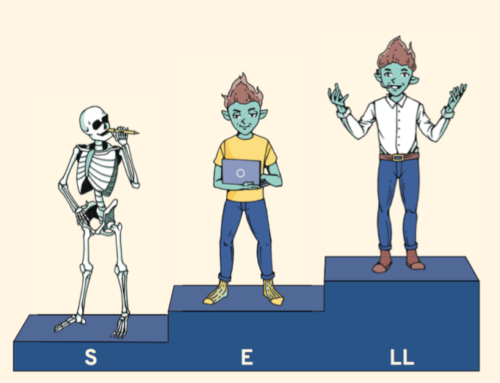Humour and science:
a user guide
Charles Dickens wrote: “There is nothing in the world so irresistibly contagious as laughter and good humour.” Humour sparks the interest of an audience and creates a bond with your spectators. But you must know how to use it! If, like us, you are a scientist and a very rational person, here are two pieces of good news. Humour appeals to the intelligence of your public. And it rests on techniques that we analysed for you. In this article, discover different ways of making people laugh…without losing credibility!

The right amount of humour, or how to stimulate your audience
According to André Comte-Sponville, “someone is guilty of being serious!”. As it happens, Tom Antion, an American expert in public speaking and humour, refers to a dull speaker as the “ZZZZ presenter”. Nobody wants their presentation to turn into a snore fest, yet scientists are not performers…So, how can you find the right balance?
Some of the usual sources of laughter must be avoided in a professional environment, for instance, situation comedy (misunderstanding), comedy relying on movements (falling), and comic characters (exaggerating a flaw). Getting on stage with a limp, mispronouncing the name of your director, or stuttering in the first minute of your presentation is more likely to make your audience uncomfortable than to make them laugh.
Nevertheless, laughter is a powerful tool, and it would be a shame not to use it. So here are a few tips to show a sense of humour without it backfiring on you.
Knowing your audience, or how to adjust jokes
Knowing your audience is key to making successful jokes. Are you talking to scientists? To the general public? Or is it a diverse audience? Depending on their age or their professional environment, people will not laugh at the same things.
For example, if you make a joke on electric cables to medical interns, they probably won’t find it funny. In the same way, the usual jokes on death found in a medical environment are likely to seem grim to outsiders. In short, the thing that makes a doctor laugh might not be funny for an engineer. Likewise, some forms of humour can be targeted at a female audience, like in this sketch of Florence Foresti: « When men get sick, they think they are about to die! » It is therefore important to adapt your witticisms to your audience.
Concise jokes, or how to avoid boring your audience
In France, we have a famous saying: “The shortest jokes are the best”. You have doubtless heard an endless joke that doesn’t make any sense (you probably won’t mind if we don’t give you an example!). As a result, nobody understands and nobody laughs. Do not venture on this slippery slope. Make short jokes.
To make sure you don’t get lost in your story, focus on the punch line. Don’t forget that humour is used to spice up your presentation. It grabs the attention of your audience, it emphasizes a few elements in your speech. Thus, make sure that your joke fits in 2 or 3 sentences, instead of embarking on a 10-minute narrative. If in doubt, do not hesitate to try out your jokes on a few test subjects beforehand. But do avoid asking friends with a lousy sense of humour for their help…
Quirky humour, or how to mock conventions
Keep in mind that humour depends on a social and cultural environment. Emmanuel Kant, a German philosopher, defended the theory according to which “humour is born when the mind perceives an unusual, unexpected or strange fact, in an incongruous word, which breaks the normal order of things”. And to harness the full potential of Homo ridens, nothing beats quirky humour. Divergence is a powerful tool with multiple facets.
In this category, we find absurd humour and paradox which defy logic or change the meaning of words. These processes toy with the difference between the expectations of the audience and the content of the speech. When the context is right, speaking of “provisional permanence”, or “fixed change” can surprise or startle your spectators!
Many quotes using divergence can be included in your speech. A research director could cite Oscar Wilde and say, “I have the simplest tastes. I am always satisfied with the best.” Or a meteorologist could quote Pierre Dac: “Making predictions is difficult, especially when they involve the future.”
Self-mockery, or how to laugh at yourself
Self-mockery has the advantage of hurting no one but you! But you must not make the mistake of sinking into self-deprecating humour, at the risk of harming your professional image. Nonetheless, there are many ways to laugh at yourself. As Tommy Cooper once said, “I used to be indecisive but now I am not quite sure”.
After attending a training course at Agent Majeur, you could say: “Before, I was a very good speaker…especially when I kept my mouth shut!” or “Public speaking is not my strong suit but hopefully you will hardly notice because my coaches are very good at it!”
Acronyms, or how to play with letters
Acronyms are an endless source of puns. And you can even ask your audience to participate and let them find a few ideas! Of course, if it is a scientific presentation, you might have a greater impact if you use acronyms such as DNA (Deoxyribonucleic Acid) or ESA (European Space Agency) instead of UFO (Unidentified Flying Object)… but who knows?
Genetically Modified Organisms (GMO) can become Glorious Mutant Organisms, or Good Morning Observers (and why not Gruesome Malefic Offspring if you have kids…). Imagination knows no bounds…other than good taste!
The opening joke, or how to begin your speech with humour
According to Anne Roumanoff, “humour is clockwork”. Pay attention to your rhythm and your timing. At which moment should you insert a touch of humour in your speech? There is no rule: it depends on the context. But if you must make a humorous presentation, you might as well set the tone from the start. Opening jokes are usually told by British speakers at the beginning of their intervention, though they have not taken root in France yet. It is a shame, since opening jokes creates an instant connection between the speaker and his audience.
You must also be careful to use humour with an audience which is willing to receive it. If you have a gloomy audience in front of you, start with light humour and keep your funnier jokes for later.
A good opening joke cannot be improvised. To quote Bernard Slade, author and scriptwriter, “it takes a lot of time to be concise, and a great deal of thought to be spontaneous”. You can especially draw inspiration from the news: recent discoveries, international awards, public events…
An example? The beginning of the speech of Pierre Février for the contest My Thesis in 180 seconds: “Last week-end, I met some high school friends and they asked me what I had become after all these years. I proudly answered: “I am doing a PhD in quantum physics.” They immediately changed the subject!”
The rule of thirds, or how to please our brain
Did you notice that we enjoy associating things in threes? “Liberty, Equality, Fraternity”, is the motto of the French Republic. A mnemonic used by first responders is “Assess, alert and attend”. There are countless examples.
This rule can be applied to humour as well, do not hesitate to use it. You can draw inspiration from this quote of Fernand Raynaud: “When I see what I see and hear what I hear, I am very happy indeed to think what I think.” You can also use this rule by relying on three specific characteristics or by telling a story with three characters, for instance.
Jokes are a serious business
Okay, we like you! To wrap up this article on humour and science, we will share one final tip with you. To correctly and successfully insert humour in your presentations, you need to practice, practice and practice again. So, get to work!
> Public Speaking
29/06/2021








